Natural Frequency Transmissibility for Detection of Cracks in Horizontal Axis Wind Turbine Blades
Abstract
:1. Introduction
1.1. Objectives
1.2. Background and Literature Review
1.2.1. Wind Turbine Blades
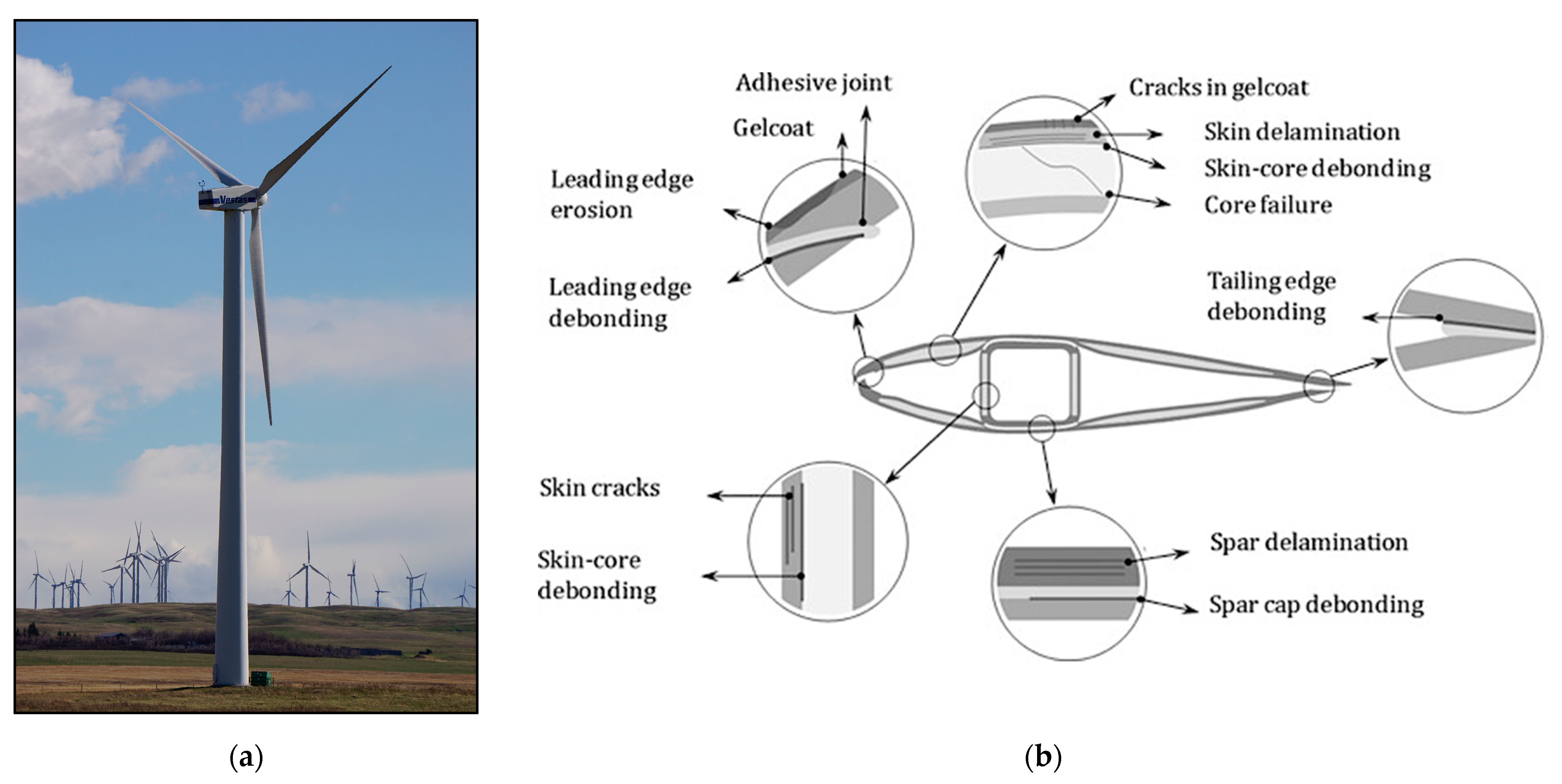
1.2.2. Inspection Methods
1.2.3. Transmissibility Theory of Single and Multiple Force Functions
1.2.4. Damage Detection Using Transmissibility
1.2.5. Transmissibility in Wind Turbine Blades
2. Materials and Methods
2.1. Experimental Set-Up
2.1.1. Blade Design and Fabrication
2.1.2. Blade Joint Adhesion
2.1.3. Sensors
2.1.4. Defect Inclusion and Repair Procedure
2.1.5. Experimental Testing Procedure
2.2. ANSYS Numerical Model
2.2.1. Model Set-Up
2.2.2. Material
2.2.3. Defect Inclusion
2.2.4. Mesh
2.2.5. Numerical Simulations Using Modal and Harmonic Analyses
2.3. Total Method
3. Results
3.1. Strain Transmissibility
3.1.1. Variables
3.1.2. Defect Identification Threshold and Confusion Matrix Development
3.1.3. Experimental Results
0.5 cm Results
1.0 cm Results
3.1.4. Numerical Results
Comparison with Experimental Results
Other Variables
3.2. Acceleration Transmissibility
3.2.1. Variables
3.2.2. Experimental Results
3.2.3. Numerical Results
4. Discussion
4.1. Transmissibility Analysis vs. Natural Frequency Analysis
4.2. Transmissibility Analysis at the Natural Frequencies
4.3. Strain Transmissibility vs. Acceleration Transmissibility
4.4. Total Method Effectiveness
4.5. Comparison with Other Transmissibility Research
5. Conclusions
Author Contributions
Funding
Data Availability Statement
Acknowledgments
Conflicts of Interest
References
- Kilpatrick, R.; Lafreniere, K.; Caceres, A. IEA Wind TCP Canada 2022. 2022. Available online: https://iea-wind.org/wp-content/uploads/2023/10/Canada_2022.pdf (accessed on 22 November 2023).
- Natural Resources Canada. Federal Government Invests in 12 New Wind, Solar and Smart-Grid Projects with Alberta Indigenous and Industry Partners. Calgary, 18 September 2023. Available online: https://www.canada.ca/en/natural-resources-canada/news/2023/09/federal-government-invests-in-12-new-wind-solar-and-smart-grid-projects-with-alberta-indigenous-and-industry-partners.html (accessed on 29 November 2023).
- SaskPower. Bekevar Wind and Power Line Project. Available online: https://www.saskpower.com/Our-Power-Future/Infrastructure-Projects/Construction-Projects/Planning-and-Construction-Projects/Bekevar-Wind-and-Power-Line-Project (accessed on 7 July 2024).
- Natural Resources Canada. Building Offshore Renewables in Newfoundland and Labrador and Nova Scotia. 30 May 2023. Available online: https://www.canada.ca/en/natural-resources-canada/news/2023/05/building-offshore-renewables-in-newfoundland-and-labrador-and-nova-scotia.html (accessed on 29 November 2023).
- Premier’s Office Natural Resources and Renewables. Province Sets Offshore Wind Target. 22 September 2022. Available online: https://novascotia.ca/news/release/?id=20220920003 (accessed on 29 November 2023).
- Vestas. V236-15.0 MW. Available online: https://www.vestas.com/en/energy-solutions/offshore-wind-turbines/V236-15MW (accessed on 7 July 2024).
- Vestas. Vestas Refurbished Turbines. Available online: https://www.vestas.com/en/products/refurbished-turbines (accessed on 29 November 2023).
- Siemens Gamesa Renewable Energy. A Clean Energy Solution—From Cradle to Grave Environmental Product Declaration SG 8.0-167 DD. Zamudio. Available online: https://www.siemensgamesa.com/en-int/-/media/siemensgamesa/downloads/en/sustainability/environment/siemens-gamesa-environmental-product-declaration-epd-sg-8-0-167.pdf (accessed on 12 September 2023).
- General Electric. Sierra Wind Platform. Available online: https://www.ge.com/renewableenergy/wind-onshore/sierra-platform/ (accessed on 29 November 2023).
- Enercon. Sustainability Report 2022. 2022. Available online: https://cdn.prod.website-files.com/64c38ca9b1a2e59bd5b7d64a/65c214deae43f54857116e27_ENERCON_Sustainability_Report_2022_low1.pdf (accessed on 7 July 2024).
- Natural Resources Canada. Canadian Wind Turbine Database. Available online: https://open.canada.ca/data/en/dataset/79fdad93-9025-49ad-ba16-c26d718cc070 (accessed on 10 September 2023).
- Bayar, T. Wind Turbine Blade Design Shift Up a Gear. Power Engineering International, 15 February 2015. Available online: https://www.powerengineeringint.com/renewables/strategic-development/sharpening-the-blade/ (accessed on 3 December 2023).
- Coultate, J. What’s the Next Big Thing in Wind Turbine Monitoring? Power Engineering, 3 June 2023. Available online: https://www.power-eng.com/om/whats-the-next-big-thing-in-wind-turbine-monitoring/#gref (accessed on 3 December 2023).
- Katsaprakakis, D.A.; Papadakis, N.; Ntintakis, I. A Comprehensive Analysis of Wind Turbine Blade Damage. Energies 2021, 14, 5974. [Google Scholar] [CrossRef]
- Mishnaevsky, L. Root Causes and Mechanisms of Failure of Wind Turbine Blades: Overview. Materials 2022, 15, 2959. [Google Scholar] [CrossRef]
- Wang, W.; Xue, Y.; He, C.; Zhao, Y. Review of the Typical Damage and Damage-Detection Methods of Large Wind Turbine Blades. Energies 2022, 15, 5672. [Google Scholar] [CrossRef]
- Ashwill, T.; Ogilvie, A.; Paquette, J. Blade Reliability Collaborative: Collection of Defect, Damage and Repair Data; Sandia National Lab.: Albuquerque, NM, USA; Livermore, CA, USA, 2013. [Google Scholar] [CrossRef]
- Hayman, B.; Wedel-Heinen, J.; Brøndsted, P. Materials Challenges in Present and Future Wind Energy. MRS Bull. 2008, 33, 343–353. [Google Scholar] [CrossRef]
- Katnam, K.B.; Comer, A.J.; Roy, D.; da Silva, L.F.M.; Young, T.M. Composite Repair in Wind Turbine Blades: An Overview. J. Adhes. 2015, 91, 113–139. [Google Scholar] [CrossRef]
- Vestas. Blade Services Expert Blade Service Solutions for All Your Turbines. 2019. Available online: https://nozebra.ipapercms.dk/Vestas/Communication/Productbrochure/PartsandRepair/blade-services1/ (accessed on 3 December 2023).
- Phase One. Drone-Captures High-Resolution Imagery for Wind Turbine Inspection with Phase One Cameras. Available online: https://geospatial.phaseone.com/case-studies/ati_wind-turbine-inspection-2/ (accessed on 9 December 2023).
- ABJ Renewables. Vestas Wind Turbine Inspection in Canada. Available online: https://abjdrones.com/vestas-wind-turbine-inspection-in-canada-with-drones/ (accessed on 9 December 2023).
- Reddy, A.; Indragandhi, V.; Ravi, L.; Subramaniyaswamy, V. Detection of Cracks and damage in wind turbine blades using artificial intelligence-based image analytics. Measurement 2019, 147, 106823. [Google Scholar] [CrossRef]
- Worzewski, T.; Krankenhagen, R.; Doroshtnasir, M.; Röllig, M.; Maierhofer, C.; Steinfurth, H. Thermographic inspection of a wind turbine rotor blade segment utilizing natural conditions as excitation source, Part I: Solar excitation for detecting deep structures in GFRP. Infrared Phys. Technol. 2016, 76, 756–766. [Google Scholar] [CrossRef]
- Worzewski, T.; Krankenhagen, R.; Doroshtnasir, M. Thermographic inspection of wind turbine rotor blade segment utilizing natural conditions as excitation source, Part II: The effect of climatic conditions on thermographic inspections—A long term outdoor experiment. Infrared Phys. Technol. 2016, 76, 767–776. [Google Scholar] [CrossRef]
- Roach, D.; Rice, T.; Paquette, J. Probability of Detection Study to Assess the Performance of Nondestructive Inspection Methods for Wind Turbine Blades; Sandia National Lab.: Albuquerque, NM, USA; Livermore, CA, USA, 2017. [Google Scholar] [CrossRef]
- Muñoz, C.Q.G.; Marquez, F.P.G.; Crespo, B.H.; Makaya, K. Structural health monitoring for delamination detection and location in wind turbine blades employing guided waves. Wind Energy 2019, 22, 698–711. [Google Scholar] [CrossRef]
- Ye, G.; Neal, B.; Boot, A.; Kappatos, V.; Selcuk, C.; Gan, T.-H. Development of an Ultrasonic NDT System for Automated In-Situ Inspection of Wind Turbine Blades. In Proceedings of the EWSHM—7th European Workshop on Structural Health Monitoring, Nantes, France, 8–11 July 2014; IFFSTTAR, Inria, Universite de Nantes: Nantes, France, 2014. Available online: https://inria.hal.science/hal-01020459/file/0156.pdf (accessed on 7 July 2024).
- Matsui, T.; Yamamoto, K.; Sumi, S.; Triruttanapiruk, N. Detection of Lightning Damage on Wind Turbine Blades Using the SCADA System. IEEE Trans. Power Deliv. 2021, 36, 777–784. [Google Scholar] [CrossRef]
- Van Dam, J.; Bond, L.J. Acoustic emission monitoring of wind turbine blades. In Proceedings of the SPIE Smart Structures and Materials + Nondestructive Evaluation and Health Monitoring, San Diego, CA, USA, 8–12 March 2015; Meyendorf, N.G., Ed.; [Google Scholar] [CrossRef]
- Tang, J.; Soua, S.; Mares, C.; Gan, T.-H. An experimental study of acoustic emission methodology for in service condition monitoring of wind turbine blades. Renew. Energy 2016, 99, 170–179. [Google Scholar] [CrossRef]
- Sensoria Edge-to-Edge Intelligence. Technology & Features. Available online: https://sensoria.com/technology/ (accessed on 10 December 2023).
- TWI Ltd. Structural Health Monitoring for Wind Turbine Blades. Available online: https://www.twi-global.com/media-and-events/insights/acoustic-emission-solution-for-structural-health-monitoring-of-wind-turbine-blades (accessed on 10 December 2023).
- Beale, C.; Willis, D.J.; Niezrecki, C.; Inalpolat, M. Passive acoustic damage detection of structural cavities using flow-induced acoustic excitations. Struct. Health Monit. 2020, 19, 751–764. [Google Scholar] [CrossRef]
- Weidmüller. Elevate Your Blade Performance. Available online: https://www.weidmueller.com/int/company/markets_industries/wind/blade_condition_monitoring.jsp#wm-1086239 (accessed on 11 December 2023).
- Di Lorenzo, E.; Petrone, G.; Manzato, S.; Peeters, B.; Desmet, W.; Marulo, F. Damage detection in wind turbine blades by using operational modal analysis. Struct. Health Monit. 2016, 15, 289–301. [Google Scholar] [CrossRef]
- Pacheco-Chérrez, J.; Probst, O. Vibration-based damage detection in a wind turbine blade through operational modal analysis under wind excitation. Mater. Today Proc. 2022, 56, 291–297. [Google Scholar] [CrossRef]
- Tcherniak, D.; Mølgaard, L.L. Active vibration-based structural health monitoring system for wind turbine blade: Demonstration on an operating Vestas V27 wind turbine. Struct. Health Monit. 2017, 16, 536–550. [Google Scholar] [CrossRef]
- Maia, N.M.M.; Almeida, R.A.B.; Urgueira, A.P.V.; Sampaio, R.P.C. Damage detection and quantification using transmissibility. Mech. Syst. Signal Process. 2011, 25, 2475–2483. [Google Scholar] [CrossRef]
- Maia, N.M.M.; Silva, J.M.M.; Ribeiro, A.M.R. The transmissibility concept in multi-degree-of-freedom systems. Mech. Syst. Signal Process. 2001, 15, 129–137. [Google Scholar] [CrossRef]
- Maia, N.M.M.; Urgueira, A.P.V.; Almei, R.A.B. Whys and Wherefores of Transmissibility. In Vibration Analysis and Control—New Trends and Developments; IntechOpen Ltd.: London, UK, 2011. [Google Scholar] [CrossRef]
- Yan, W.J.; Zhao, M.Y.; Sun, Q.; Ren, W.X. Transmissibility-based system identification for structural health Monitoring: Fundamentals, approaches, and applications. Mech. Syst. Signal Process. 2019, 117, 453–482. [Google Scholar] [CrossRef]
- Chesné, S.; Deraemaeker, A. Damage localization using transmissibility functions: A critical review. Mech. Syst. Signal Process. 2013, 38, 569–584. [Google Scholar] [CrossRef]
- Devriendt, C.; Guillaume, P. The use of transmissibility measurements in output-only modal analysis. Mech. Syst. Signal Process. 2007, 21, 2689–2696. [Google Scholar] [CrossRef]
- Johnson, T.J.; Adams, D.E. Transmissibility as a Differential Indicator of Structural Damage. J. Vib. Acoust. 2002, 124, 634–641. [Google Scholar] [CrossRef]
- Zhang, H.; Schulz, M.J.; Naser, A.; Ferguson, F.; Pai, P.F. Structural health monitoring using transmittance functions. Mech. Syst. Signal Process. 1999, 13, 765–787. [Google Scholar] [CrossRef]
- Devriendt, C.; Presezniak, F.; De Sitter, G.; Vanbrabant, K.; De Troyer, T.; Vanlanduit, S.; Guillaume, P. Structural Health Monitoring in Changing Operational Conditions Using Tranmissibility Measurements. Shock. Vib. 2010, 17, 153273. [Google Scholar] [CrossRef]
- Ghoshal, A.; Sundaresan, M.J.; Schulz, M.J.; Pai, P.F. Structural health monitoring techniques for wind turbine blades. J. Wind. Eng. Ind. Aerodyn. 2000, 85, 309–324. [Google Scholar] [CrossRef]
- Cheng, L.; Busca, G.; Roberto, P.; Vanali, M.; Cigada, A. Damage Detection Based on Strain Transmissibility for Beam Structure by Using Distributed Fiber Optics. In Structural Health Monitoring & Damage Detection; Niezrecki, C., Ed.; Springer International Publishing: Cham, Switzerland, 2017; Volume 7, pp. 27–40. [Google Scholar]
- Zou, Y.; Lu, X.; Yang, J.; Wang, T.; He, X. Structural Damage Identification Based on Transmissibility in Time Domain. Sensors 2022, 22, 393. [Google Scholar] [CrossRef] [PubMed]
- Fan, Z.; Feng, X.; Zhou, J. A novel transmissibility concept based on wavelet transform for structural damage detection. Smart Struct. Syst. 2013, 12, 291–308. [Google Scholar] [CrossRef]
- Yang, W.; Lang, Z.; Tian, W. Condition Monitoring and Damage Location of Wind Turbine Blades by Frequency Response Transmissibility Analysis. IEEE Trans. Ind. Electron. 2015, 62, 6558–6564. [Google Scholar] [CrossRef]
- Wang, X.; Zhang, L.; Heath, W.P. Wavelet Energy Transmissibility Analysis for Wind Turbine Blades Fault Detection. In Proceedings of the 2020 IEEE Applied Power Electronics Conference and Exposition (APEC), New Orleans, LA, USA, 15–19 March 2020; pp. 152–156. [Google Scholar] [CrossRef]
- Wang, X.; Zhang, L.; Heath, W.P. Wind turbine blades fault detection using system identification-based transmissibility analysis. Insight Non-Destr. Test. Cond. Monit. 2022, 64, 164–169. [Google Scholar] [CrossRef]
- Gaertner, E.; Rinker, J.; Sethuraman, L.; Zahle, F.; Anderson, B.; Barter, G.; Abbas, N.; Meng, F.; Bortolotti, P.; Skrzypinski, W.; et al. Definition of the IEA 15-Megawatt Offshore Reference Wind. Mar. 2020. Available online: https://www.nrel.gov/docs/fy20osti/75698.pdf (accessed on 14 May 2023).
- Raise3D. Raise3D Pro2 3D Printer. Available online: https://www.raise3d.com/products/pro2-3d-printer/ (accessed on 24 July 2023).
- Raise3D. Raise3D Premium PLA Technical Data Sheet. Version 5.1. Available online: https://s1.raise3d.com/2023/02/Raise3D-Premium_PLA_TDS_V5.1_EN.pdf (accessed on 10 July 2023).
- Glue, K. Products. Available online: https://www.krazyglue.com/products.html (accessed on 9 March 2024).
- InvenSense Inc. MPU-6000 and MPU-6050 Product Specification. PS-MPU-6000A-00. Available online: https://invensense.tdk.com/wp-content/uploads/2015/02/MPU-6000-Datasheet1.pdf (accessed on 12 August 2023).
- FEIN. FEIN Multimaster. Available online: https://fein.com/en_ca/machines/oscillating-multi-tools/multimaster/ (accessed on 25 August 2023).
- MYNT3D. MYNT3D 3d Pen PRO. Available online: https://www.mynt3d.com/products/3d-printing-pen (accessed on 25 August 2023).
- Arduino. Arduino Uno R3. Available online: https://docs.arduino.cc/hardware/uno-rev3 (accessed on 12 August 2023).
- Ibsen Photonics. I-MON 512 High Speed. Available online: https://ibsen.com/product/i-mon-512-high-speed/ (accessed on 30 July 2023).
- Ibsen Photonics. Ibsen Photonics-DL-BP1-1501A SLED. Available online: https://ibsen.com/product/light-source-for-fbg-sensing/ (accessed on 10 July 2023).
- ANSYS. Elevate Engineering Design 2022 Product Releases & Updates. Available online: https://www.ansys.com/en-gb/products/release-highlights-backup (accessed on 10 March 2024).
- Ferreira, R.T.L.; Amatte, I.C.; Dutra, T.A.; Bürger, D. Experimental characterization and micrography of 3D printed PLA and PLA reinforced with short carbon fibers. Compos. B Eng. 2017, 124, 88–100. [Google Scholar] [CrossRef]
- Medel, F.; Abad, J.; Esteban, V. Stiffness and damping behavior of 3D printed specimens. Polym. Test. 2022, 109, 107529. [Google Scholar] [CrossRef]
- Larner, A.J. The 2 × 2 Matrix; Springer International Publishing: Cham, Switzerland, 2021. [Google Scholar] [CrossRef]
- Scikit-Learn. Available online: https://scikit-learn.org/stable/index.html (accessed on 15 February 2024).
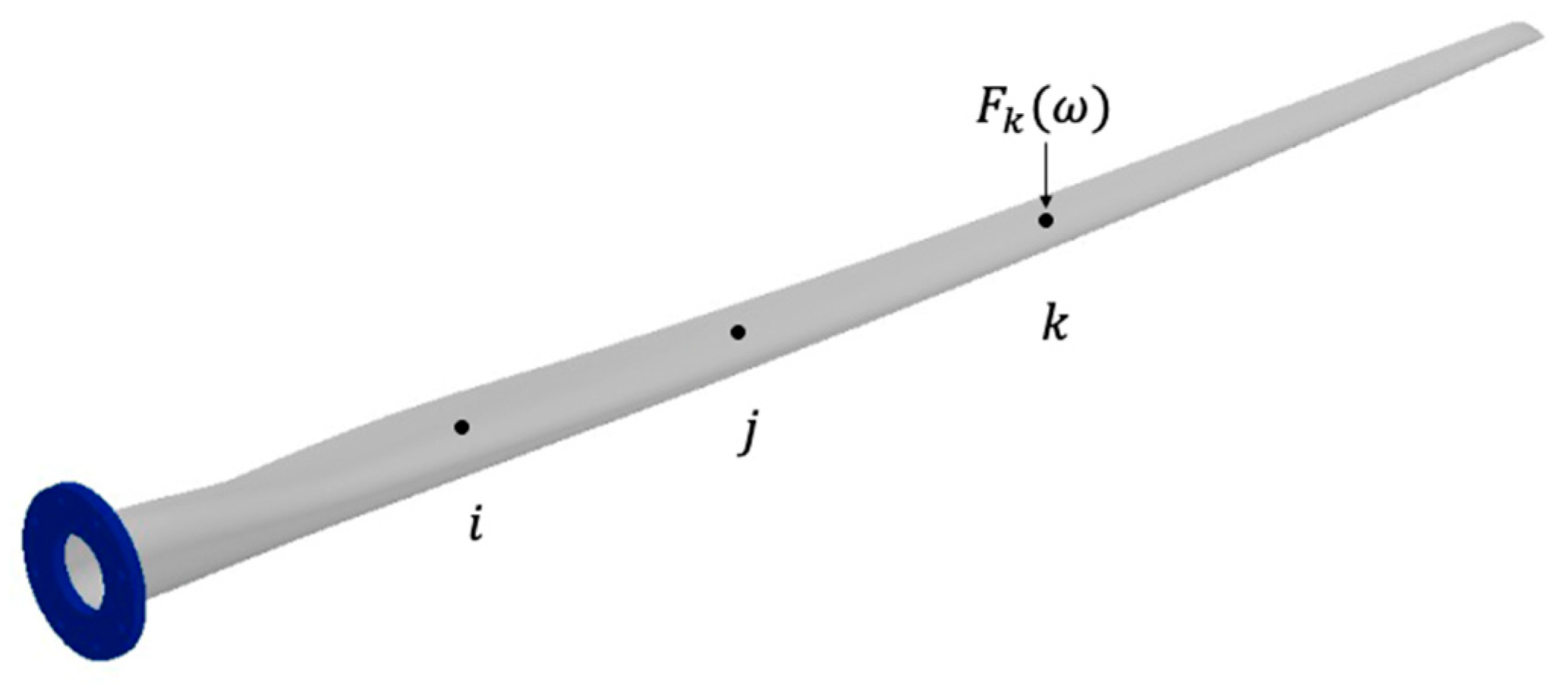
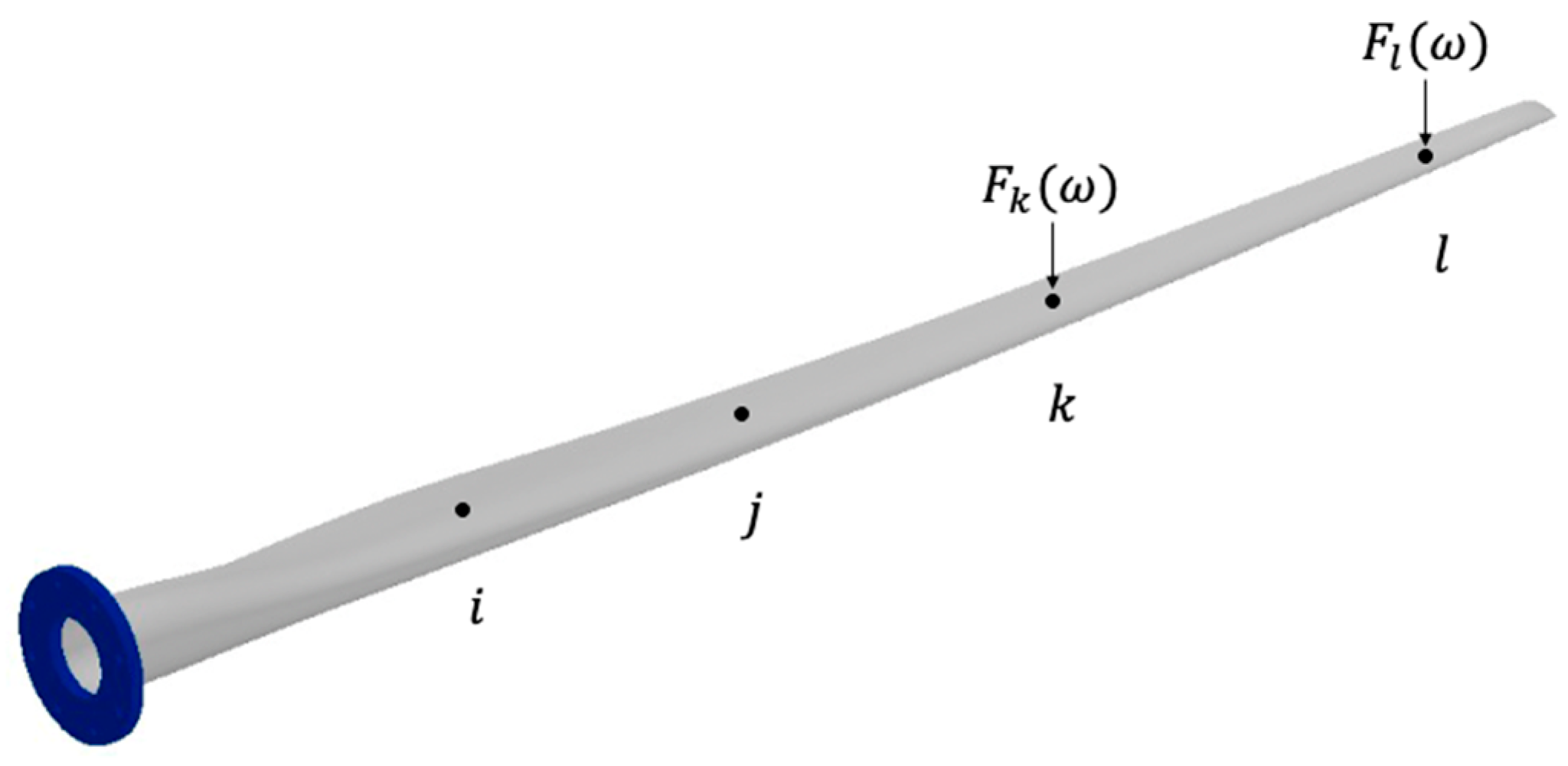
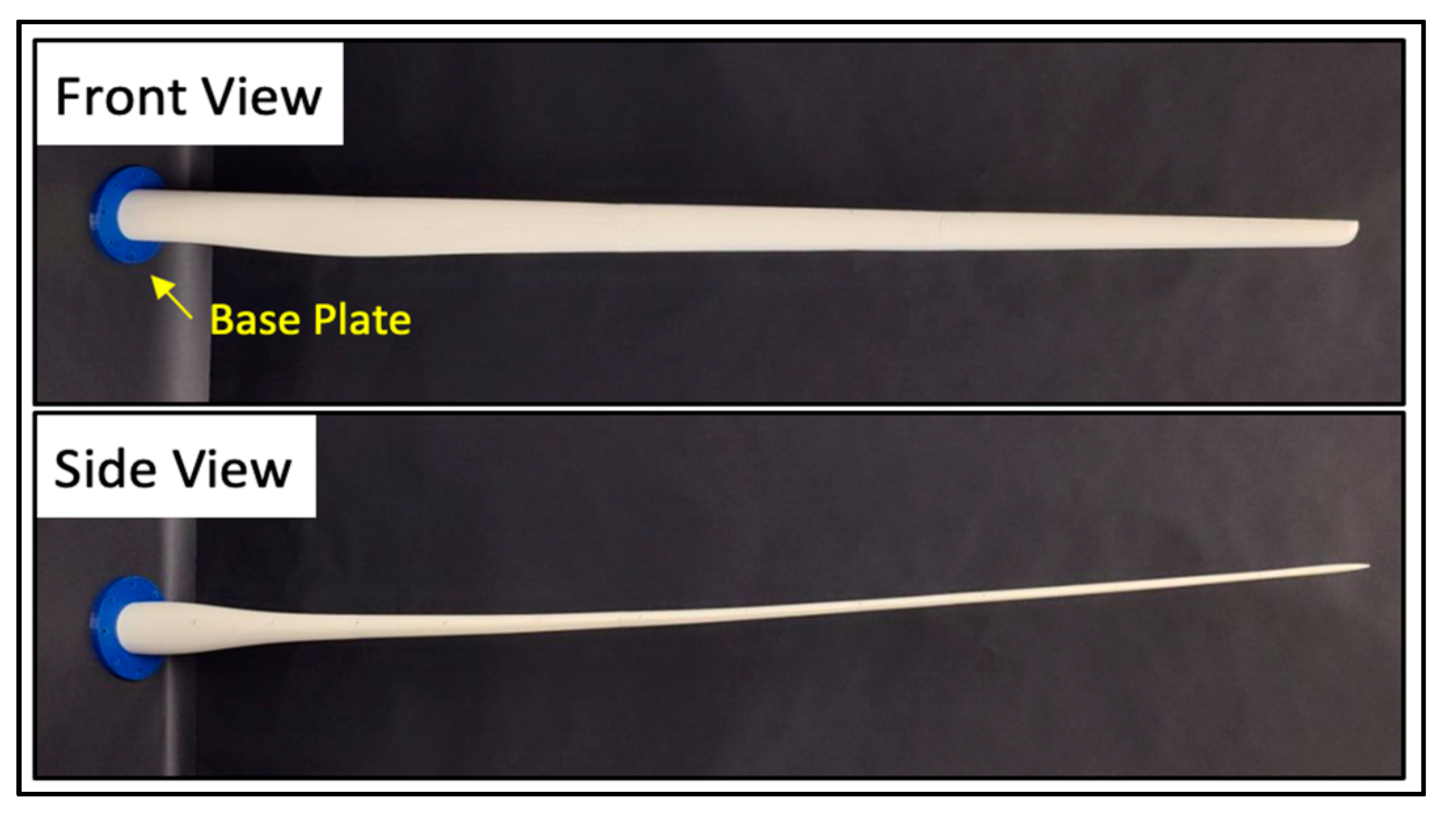
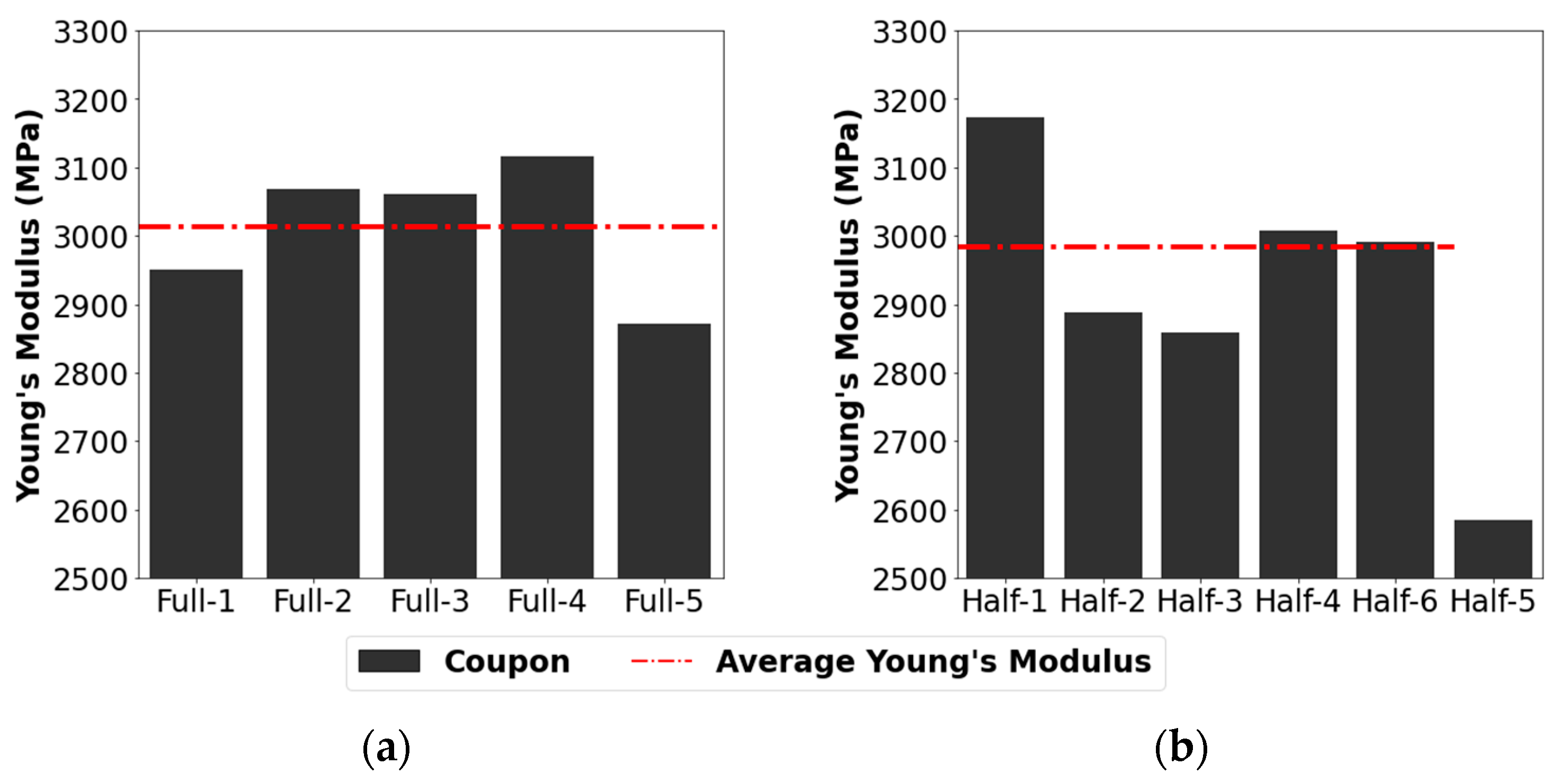

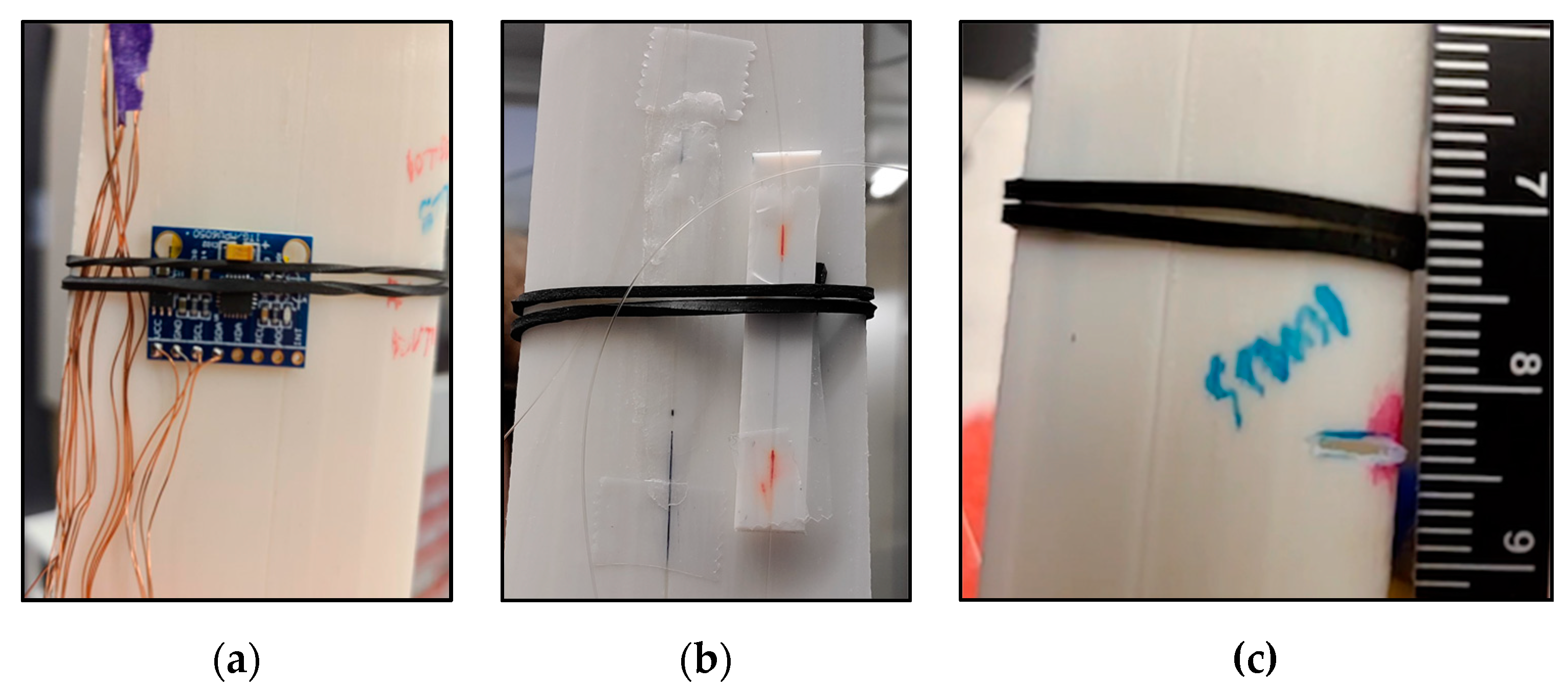
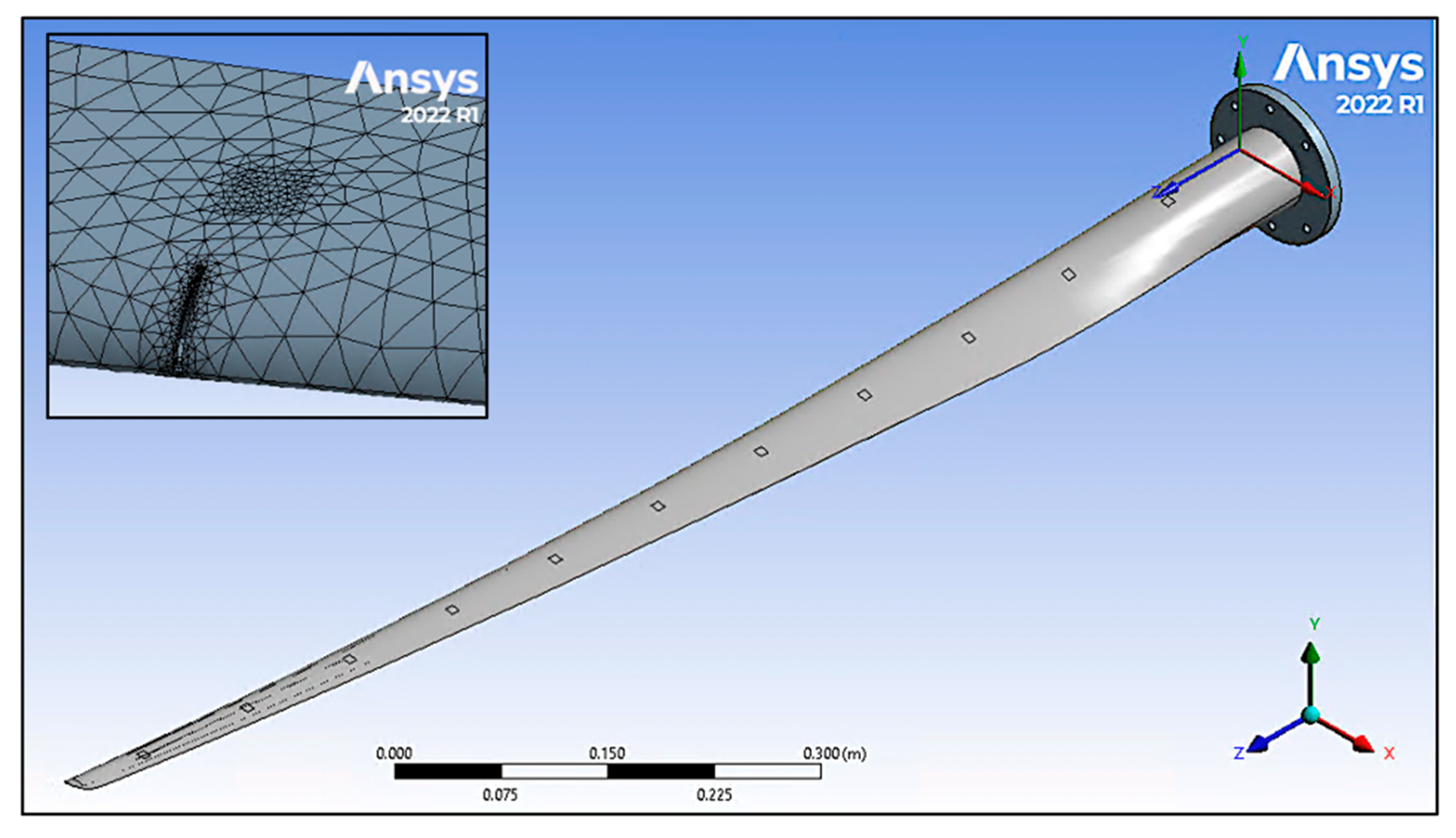

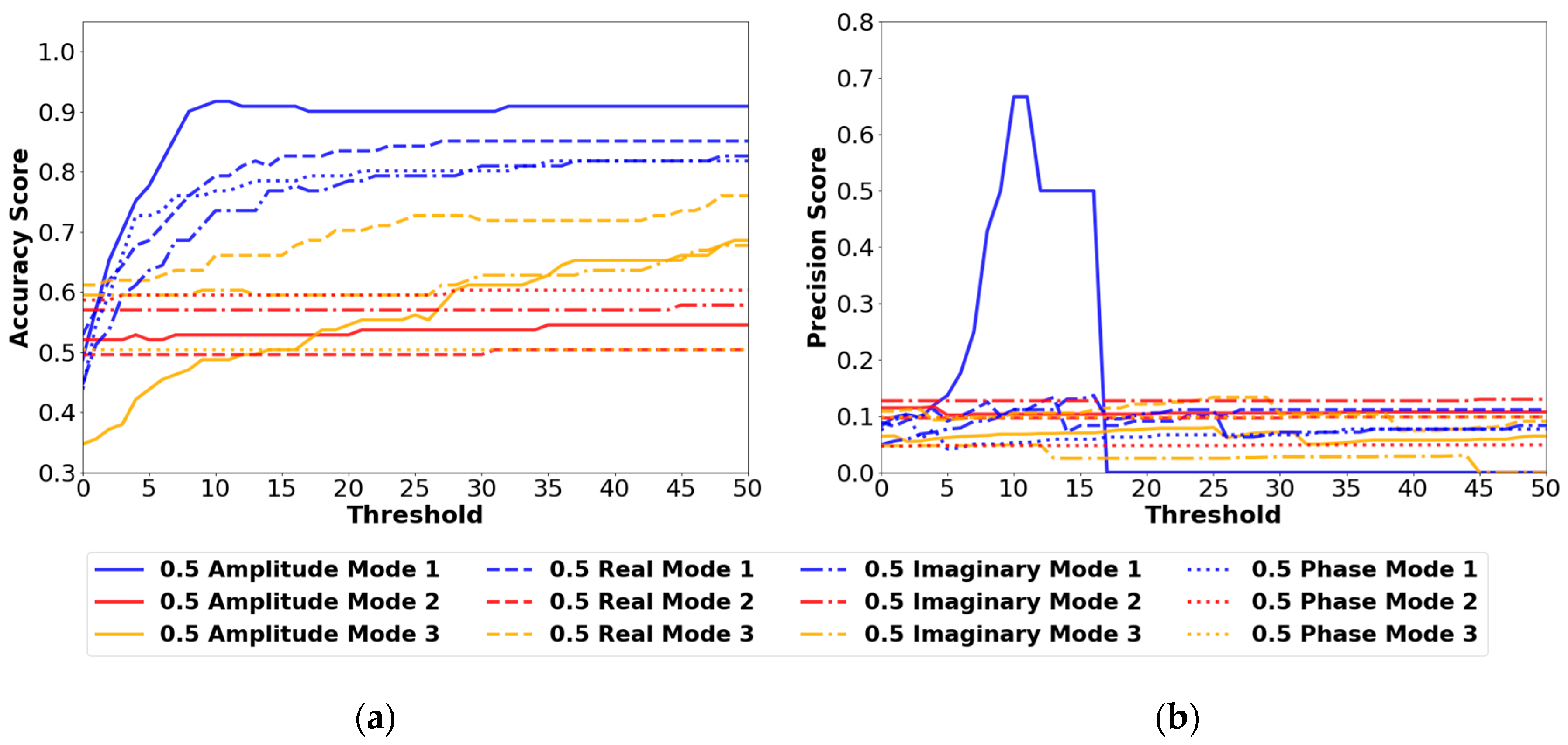

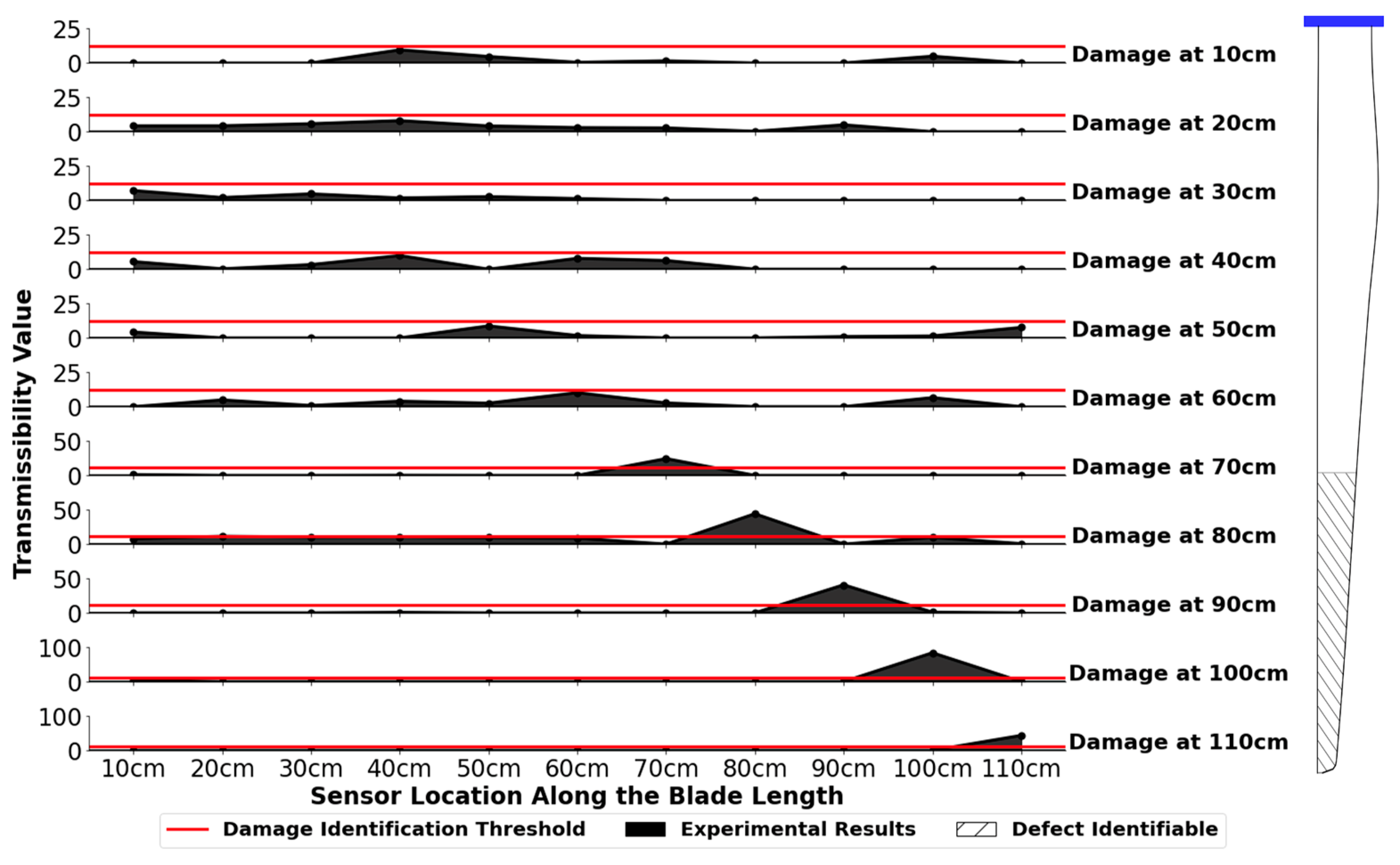

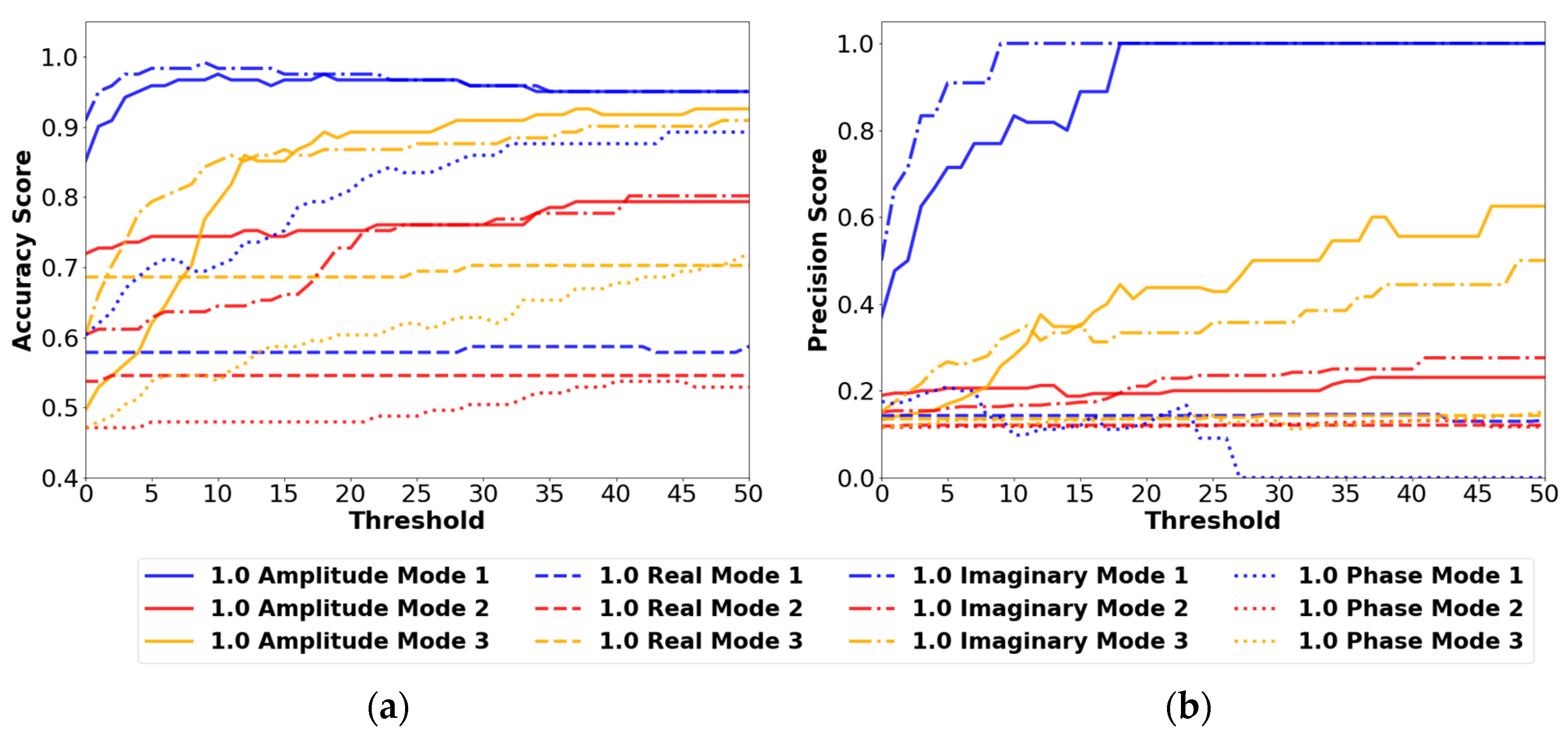

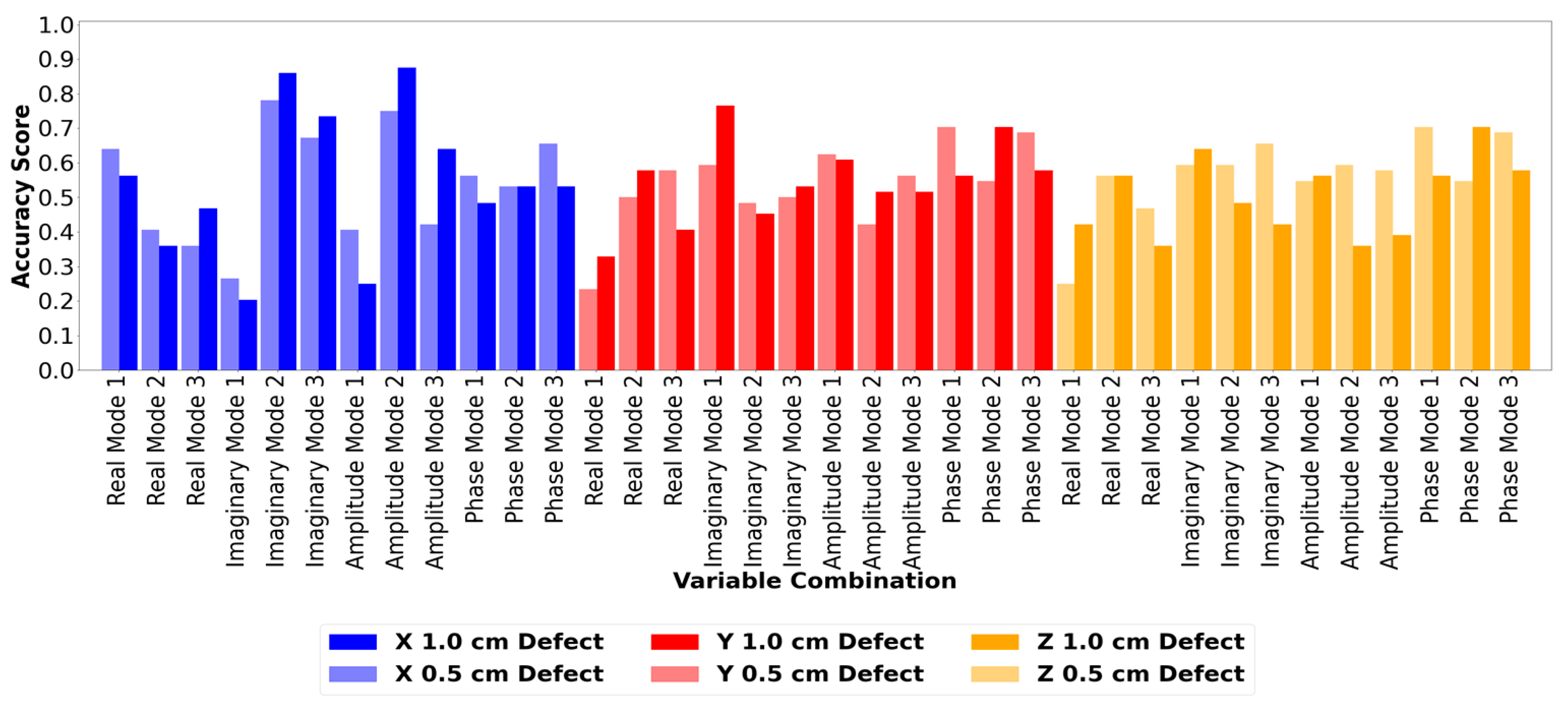

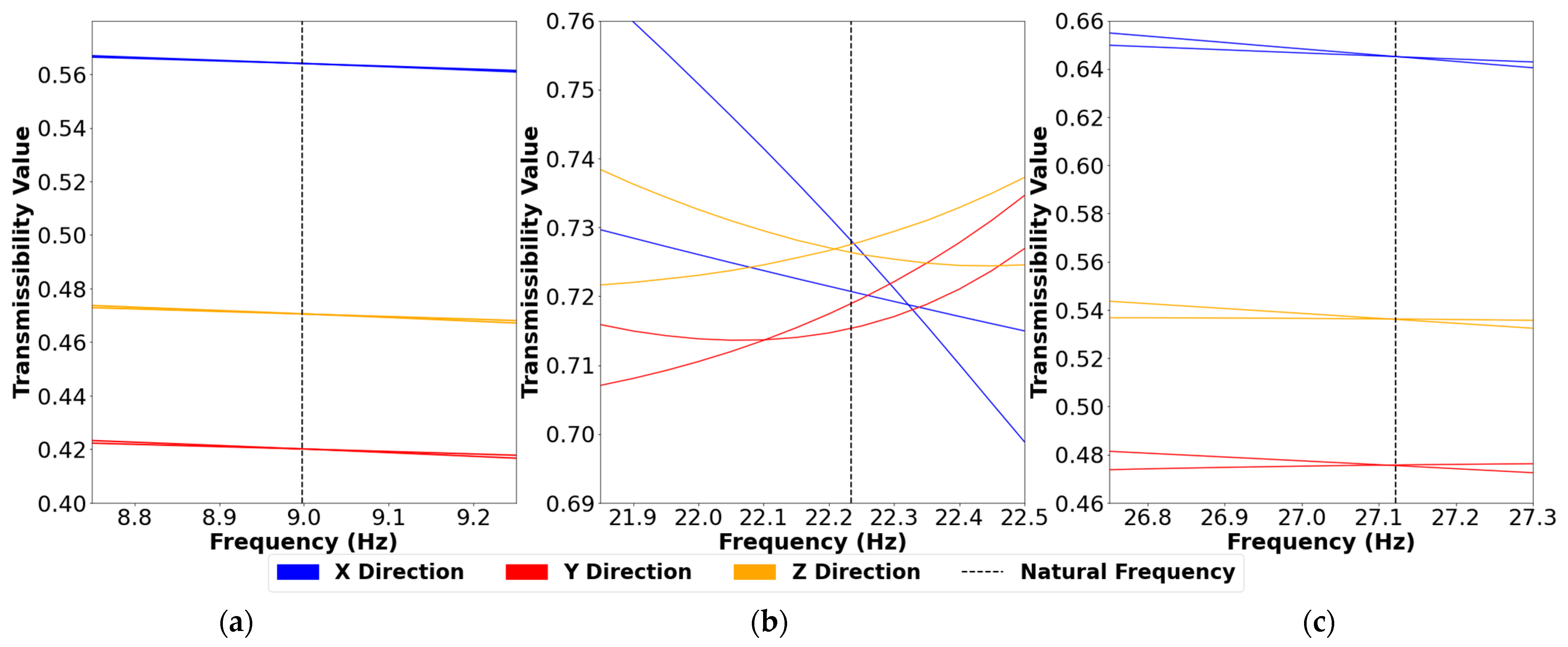
| Young’s Modulus (MPa) | Density (kg/m3) | Poisson’s Ratio |
|---|---|---|
| 2984 | 1128 | 0.33 [66] |
| Vibration Mode | ANSYS Natural Frequency (Hz) | Experimental Natural Frequency (Hz) |
|---|---|---|
| 1 | 8.998 | 8.990 |
| 2 | 22.234 | 22.133 |
| 3 | 27.122 | 27.150 |
| Variable Type | FBG Experimental Variables Examined | ANSYS Numerical Variables Examined |
|---|---|---|
| Defect Size | 0.5 cm, 1.0 cm | 0.5 cm, 1.0 cm |
| Vibration Mode Number | 1, 2, 3 | 1, 2, 3 |
| Strain Orientation | Z | X, Y, Z |
| Signal Type | Real, Imaginary, Amplitude, Phase | Real, Imaginary, Amplitude, Phase |
| Variable Type | MPU-6050 Experimental Variables Examined | ANSYS Numerical Variables Examined |
|---|---|---|
| Defect Size | 0.5 cm, 1.0 cm | 0.5 cm, 1.0 cm |
| Vibration Mode Number | 1, 2, 3 | 1, 2, 3 |
| Strain Orientation | X, Y | X, Y, Z |
| Signal Type | Real, Imaginary, Amplitude, Phase | Real, Imaginary, Amplitude, Phase |
Disclaimer/Publisher’s Note: The statements, opinions and data contained in all publications are solely those of the individual author(s) and contributor(s) and not of MDPI and/or the editor(s). MDPI and/or the editor(s) disclaim responsibility for any injury to people or property resulting from any ideas, methods, instructions or products referred to in the content. |
© 2024 by the authors. Licensee MDPI, Basel, Switzerland. This article is an open access article distributed under the terms and conditions of the Creative Commons Attribution (CC BY) license (https://creativecommons.org/licenses/by/4.0/).
Share and Cite
Henderson, R.; Azhari, F.; Sinclair, A. Natural Frequency Transmissibility for Detection of Cracks in Horizontal Axis Wind Turbine Blades. Sensors 2024, 24, 4456. https://doi.org/10.3390/s24144456
Henderson R, Azhari F, Sinclair A. Natural Frequency Transmissibility for Detection of Cracks in Horizontal Axis Wind Turbine Blades. Sensors. 2024; 24(14):4456. https://doi.org/10.3390/s24144456
Chicago/Turabian StyleHenderson, Rachel, Fae Azhari, and Anthony Sinclair. 2024. "Natural Frequency Transmissibility for Detection of Cracks in Horizontal Axis Wind Turbine Blades" Sensors 24, no. 14: 4456. https://doi.org/10.3390/s24144456
APA StyleHenderson, R., Azhari, F., & Sinclair, A. (2024). Natural Frequency Transmissibility for Detection of Cracks in Horizontal Axis Wind Turbine Blades. Sensors, 24(14), 4456. https://doi.org/10.3390/s24144456








